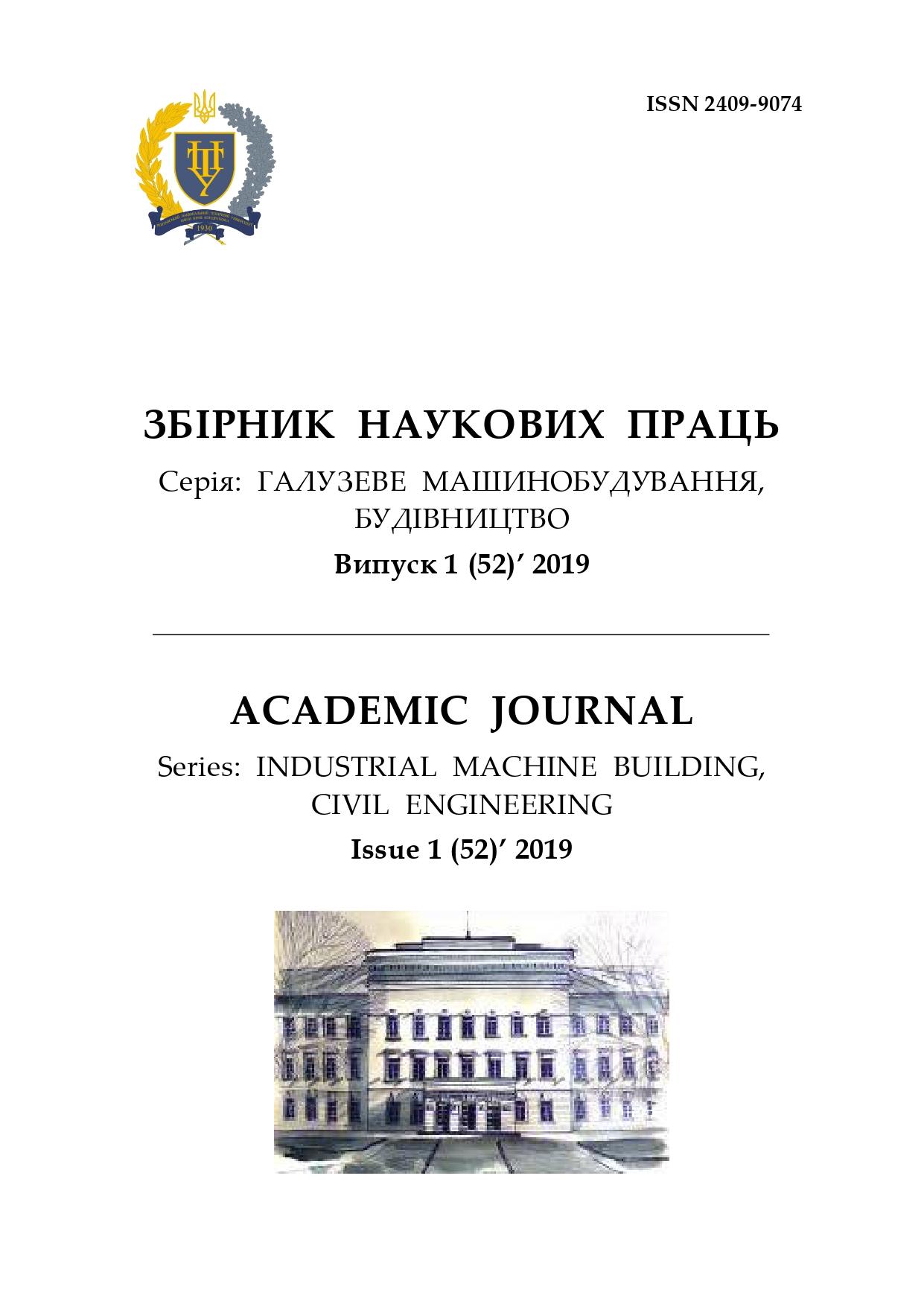Удосконалена методика розрахунку міцності залізобетонних елементів за похилими перерізами
DOI:
https://doi.org/10.26906/znp.2019.52.1679Ключові слова:
фермова аналогія, дискова модель, межа реалізації випадків руйнування, мінімальне значення граничних зусиль, коефіцієнт поперечного армуванняАнотація
Встановлені межі застосування методів фермової аналогії та дискової моделі для розрахунку міцності за похилими
перерізами залізобетонних елементів, що згинаються. Визначені області реалізації руйнування залізобетонних конс-
трукцій за умовним стиснутим елементом (похилою смугою) на дію поперечною сили та стиснутою зоною над не-
безпечною похилою тріщиною на основі застосуванням критерію мінімуму граничного зусилля, що сприймається
елементами. Розрахункові залежності приведені до єдиної основи. Отримані дані щодо значень коефіцієнта попереч-
ного армування елементів на межі руйнування від зрізу похилої смуги та стиснутої зони над небезпечною тріщиною.
Уточнено вплив класу бетону, відносного прольоту зрізу та інтенсивності поперечного армування на міцність еле-
ментів, що підтверджується експериментальними дослідженнями. Для інтегрального оцінювання факторів впливу
розглянуто задачу міцності похилої призми, завантаженої на торцях стиснутою нормальною та дотичною силами.
Бетон розглядається як жорстко-пластичне тіло. Локалізація пластичної деформації в тонких шарах на поверхні руй-
нування є характерною для граничного стану бетону при зрізі. Аналіз отриманих варіаційний методом у теорії плас-
тичності результатів дозволяє внести обґрунтовані зміни до визначення міцності стиснутого похилого елемента.
Уточнена методика розрахунку міцності залізобетонних конструкцій за похилими перерізами на дію поперечної си-
ли дозволяє отримати більш ефективні конструктивні рішення. Для інженерних розрахунків міцності запропонована
залежність щодо визначення коефіцієнта поперечного армування ділянок конструкцій біля опор, який відповідає
межі розглянутих випадків руйнування за похилим елементом та стиснутою зоною над небезпечною похилою трі-
щиною. Встановлена перспективність застосування теорії пластичності для вдосконалення конструктивних рішень
згинальних залізобетонних елементів на основі подальшого уточнені міцності похилого елемента як складової фер-
мової аналогії, стиснутої зони над небезпечною тріщиною і системного дослідження зрізу.
Посилання
Grandić, D., Šćulac, P. & Štimac Grandić, I. (2015).
Shear resistance of reinforced concrete beams in dependence
on concrete strength in compressive struts. Tehnicki Vjesnik,
(4), 925-934
https://doi.org/10.17559/TV-20140708125658
Latha, M., Revanasiddappa, M. & Naveen Kumar, B.M.
(2018). Influence of stirrup spacing on shear resistance and
deformation of reinforced concrete beam. International
Journal of Engineering & Technology, 7(1), 126-134.
http://dx.doi.org/10.14419/ijet.v7i1.9013
Collins, M.P., Bentz, E.C., Sherwood, E.G. & Xi, L.
(2007). An adequate theory for the shear reinforced concrete
structure. Proc. of the Morley Symposium on Concrete Plasticity
and its Application, 75-94.
http://dx.doi.org/10.1680/macr.2008.60.9.635
Gurley, C.R. (2008). Plastic Shear Strength of
Continuous Reinforced Beams, NZSEE Conference, 19.
Mitrofanov, V.P. (2000). Optimization strength theory
of reinforced concrete bar elements and structures with
practical aspects of its use. Bygningsstatiske Meddelelser,
(4), 73-125.
Klimov, Yu.A. (1999). To calculate the strength of
reinforced concrete elements in inclined sections. Taurian
Scientific Bulletin: a collection of scientific articles, 11,
-17.
Zalesov, A.S. & Klimov, Yu.A. (1989). Strength of reinforced
concrete structures under the action of transverse
forces. Kiev.
Wei, W. & Gong, J. (2011). Shear strength prediction of
reinforced concrete flexural members with stirrups based on
modified compression field theory. Journal of Building, 32,
-141.
Braz. D.H, Barros. R. & Da Silva Filho. J.N. (2019).
Comparative analysis among standards of the area calculation
of transversal reinforcement on reinforced concrete
beams of high resistance subjected by shear force, Rev.
IBRACON Estrut. Mater., 12(1).
http://dx.doi.org/10.1590/s1983-41952019000100011
Snezhkina. O.V. (2019). Engineering method for assessing
the strength of reinforced concrete beams, IOP Conf.
Ser.: Mater. Sci. Eng.
https://dx.doi.org/10.1088/1757-899X/537/2/022050
Korniychuk, O.I. (2012). Bearing capacity calculation
of flexural reinforced concrete elements inclined sections
according to normative documents DBN B.2.6-98 and DSTU
B B.2.6-156, Resource-economical materials, buildings,
structures: Collection of scientific works. 29, 269-274.
Kolchunov, V.I. (1997). On the calculation of crack resistance
and strength of rod reinforced concrete elements
over inclined sections. Resource-saving structural and technological
solutions of buildings and equipment, Belgorod,
-167.
DBN B.2.6-98: 2009. (2011). Construction of buildings
and structures. Concrete and reinforced concrete structures.
Substantive provisions. Kyiv: Minregionstroy of
Ukraine.
DSTU B V.2.6-156: 2010. (2011). Concrete and reinforced
structures of heavy concrete. Design rules. Kyiv:
Minregionstroy of Ukraine, SE "Ukrhbudinform".
SNiP 2.03.01-84* (1989). Concrete and reinforced
concrete structures. Moscow.
Dovzhenko, O.O., Pohribnyi, V.V. & Kurilenko, O.O.
(2012). The possibility of applying the plasticity theory to
the strength calculation of high-strength concrete elements.
Utilities of cities, 105, 74-82.
Pohribnyi, V., Dovzhenko, O., Karabash, L. & Usenko,
I. (2017). The design of concrete elements strength under
local compression based on the variational method in the
plasticity theory. Web of Conferences, 116, 02026.
https://doi.org/10.1051/matecconf/201711602026
Ma, Y., Lu, B., Guo, Z., Wang, L., Chen, H. &
Zhang, J. (2019). Limit equilibrium method-based shear
strength prediction for corroded reinforced concrete beam
with inclined bars, Materials (Basel), 12(7).
https://doi.org/10.3390/ma12071014
Lee D.H., Han, S.‐J. & Kim. K.S. (2016). Dual potential
capacity model for reinforced concrete beams subjected
to shear, Structural Concrete, 17(3), 443-456.
https://doi.org/10.1002/suco.201500165
Dovzhenko, O., Pogrebnyi, V., Pents, V. &
Мariukha, D. (2018). Bearing capacity calculation of reinforced
concrete corbels under the shear action, MATEC Web
Conferences, 230.
https://doi.org/10.1051/matecconf/201823002005
Pohribnyi, V., Dovzhenko, O. & Maliovana, O. (2018).
Aspects of usage of the ideal plasticity theory to concrete
and reinforced concrete, International Journal of Engineering
& Technology, 7(3.2), 19-26.
http://dx.doi.org/10.14419/ijet.v7i3.2.14369
Nielsen, M.P. & Hoang, L. (2016). Limit Analysis and
Concrete Plasticity. CRC Press. Taylor & Francis Group.
Braestrup, M.W. (2019). Concrete plasticity – a historical
perspective. Proc. of the fib Symposium: Concrete ‒
Innovations in Materials, Design and Structures, Krakov,
Poland, 29-48.
Kolmogorov, V.L. (1986). Mechanics of metal processing
by pressure. Moscow.
Mitrofanov, V.P. (2006). The theory of perfect plasticity
as the elementary mechanic pseudo-plastic ultimate state
of concrete: bases, imitations, practical aspects. Proceedings
of the 2nd fib Congress, 7-6.
Mitrofanov, V., Pogrebnoy, V. & Dovzhenko, O.
(2006). Strength of Concrete Elements Under Shear Action
According to the Theory of Plasticity and tests. Proceeding
of the 2nd fib Congress, 284-285.
Mitrofanov, V.P., Dovzhenko, O.O. & Pohribnyi, V.V.
(2002). On the possibility of applying the precondition for
perfect plasticity to concrete. Bulletin of the Odessa
State Academy of Civil Engineering and Architecture, 7,
-124.
Genius, G.A., Kissyuk, V.N. & Tyupin, G.A. (1974).
Theory of plasticity of concrete and reinforced concrete.
Moscow.
Downloads
Опубліковано
Як цитувати
Номер
Розділ
Published 2019-07-05




